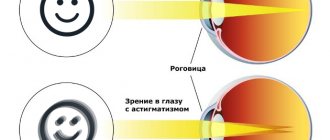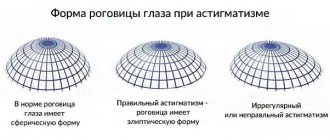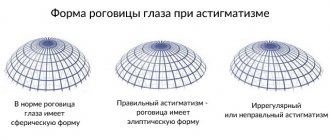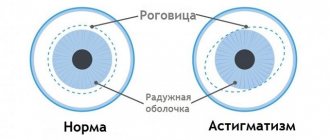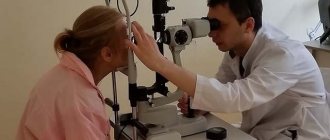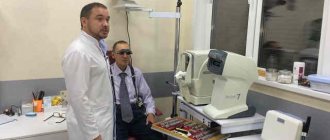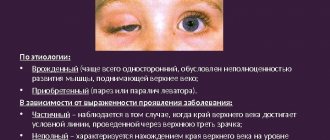Astigmatism in medicine is not considered a disease; it is an eye condition that can appear due to various factors. Most often, this is a hereditary pathology, but astigmatism often manifests itself in people whose relatives have not encountered such a deviation. Young people with astigmatism are concerned about the question: will they be accepted into the army with this pathology? This article will give a detailed answer to this question and analyze various situations depending on the degree of pathological changes in the conscript’s visual organs.
Share
Tweet
Share
Cool
Send
Briefly about pathology
Translated from Latin, this pathology’s name sounds like “lack of a focal point.” This translation reflects the main problem of astigmatism as accurately as possible.
In a normal state, the cornea and lens of the eye have a smooth surface; with astigmatism, the surfaces of these structures are curved. For this reason, the visual image in a person with this pathology is formed incorrectly, because the light partially goes behind the retina, and only some of it remains in front of it. A person with astigmatism sees objects in a distorted form - part of the object is normal, part is blurry.
Reference! To understand how a person with astigmatism sees, you can look at your reflection in a teaspoon.
In addition to distorted perception of objects, a person suffering from astigmatism complains of pain and pain in the eyes, fatigue and headache. With prolonged loads, the ability to determine the distance to an object is lost.
The approach to choosing treatment tactics depends on the severity of symptoms and their impact on visual acuity. In general, options for correcting a defect can be divided into three groups:
- Correction with glasses is the first step in solving the problem. By selecting the most suitable glasses, you can improve the patient's vision.
- Hard contact lenses - these lenses are worn at night and affect the shape of the cornea, gradually bringing it closer to the normal version.
- Surgical intervention - you can quickly and quite effectively change the shape of the cornea using photorefractive keratectomy, astigmatic keratomy, laser keratoplasty, thermokeratocoagulation and some other methods. Surgery to replace the lens or implant permanent lenses inside the eye is also possible. The decision on surgical intervention is made only upon reaching adulthood, and all possible risks and the readiness of the patient’s body for surgery must be taken into account.
Causes
As already mentioned, the main cause of astigmatism is a hereditary predisposition. In this case, the pathology develops in utero during the formation of the lens and cornea. However, in some cases, acquired astigmatism is observed - the child is born with normal vision, but for some reason the shape of the lens changes.
The causes of acquired astigmatism can be:
- corneal injuries;
- lens injuries;
- keratitis and other inflammatory diseases of the cornea;
- keratoconus – thinning of the cornea;
- medical manipulations - incorrect suture in the cornea area, too much suturing of its edges, and so on;
- diseases of the upper jaw and teeth - these pathologies can be combined with deformation of the orbital wall, which in turn leads to the development of astigmatism.
Causes
The development of this disease is based on a genetic predisposition to disruption of the structure of the cornea. At the same time, astigmatism can occur when exposed to the following factors:
- traumatic eye injury;
- long-term severe inflammatory diseases;
- increased intraocular pressure;
- circulatory disorders in the vessels of the eye;
- improper healing of incisions after surgery;
- constant eye strain, etc.
Complex astigmatism is acquired, in contrast to simple astigmatism, which is often congenital.
Categories of suitability for eye pathologies
It is on what type of astigmatism a young man has that his suitability for military service in the army depends. Suitability is indicated by alphabetic symbols and appears as follows.
| Suitability category | Description |
| A | Deviations in the functioning of the organs of vision and in other systems. |
| B | The functionality of vision is impaired by 2-4 diopters. These young people can serve in the army, however, there are some restrictions on their activities. For example, a young man will be taken into the army, service in which involves active physical activity. |
| IN | The vision function is deviated by 4-6 diopters. In this case, the young man can only be drafted into the army if wartime is declared. Its suitability in the conscript army is limited. However, after undergoing appropriate treatment and restoration of vision, after 2-3 years he may receive a summons from the military registration and enlistment office. Without undergoing treatment, conscription into the army is impossible. |
| G | Visual impairment is 6-7 diopters. The young man will not receive a summons, since military service can lead to various complications in his visual system. In case of adequate treatment and improvement of vision, the summons can be sent again. |
| D | Completely unsuitable for military service. There are serious deviations in the visual apparatus, and complications develop. Such a young man will never be drafted into the army. |
Astigmatism and the military medical commission
The military medical commission includes doctors of various specializations, including an ophthalmologist. The goal of doctors is to assess the health status of the conscript and determine his suitability for military service.
During the examination of young people, the medical commission examines all existing diseases of conscripts based on a general examination, medical history and the presence of documents and certificates from other doctors in the young people. After which a conclusion is made about the conscript’s suitability for service - conscripts are distributed into categories and groups - suitability, partial suitability, deferment, unfitness.
With weak or moderate degrees of visual acuity impairment, in which visual acuity is preserved, young people are considered fit for military service - in whole or in part.
The visual acuity of a conscript is assessed taking into account corrective means, so young people with ophthalmological disorders must appear for a medical examination with lenses or glasses.
Astigmatism and military service are quite compatible, however, young people are accepted into the armed forces, taking into account the severity of the pathology.
Expert opinion
Kim Oksana Alexandrovna
Head of the ophthalmology clinic. Ophthalmologist with more than 10 years of experience.
Only an ophthalmologist can determine the degree when a young person undergoes a medical examination at the military registration and enlistment office. To accurately determine the degree of pathology, the doctor must carefully examine the refraction of the eye. This is possible using a refractometer or skiascope. As a rule, to install as accurately as possible, both research options are used at once. To determine whether a young man is fit for military service, the pathology must be determined in at least one eye, and its degree must also be determined.
During the examination procedure, the doctor may use special drops, after which vision will deteriorate somewhat for some time, especially when viewing objects in the sun. These drugs are called mydriatics - means for dilating the pupil, with their help you can study the condition of the fundus in detail. Mydriatics include Tropicamide, Atropine and other eye drops.
Prevention
Since myopia in most cases appears due to eye fatigue, it is necessary to follow preventive measures:
- do not strain your eyes by reading for too long, take a break every hour;
- sit with a straight back while reading or working at the computer;
- Perform eye exercises daily;
- ensure bright lighting while reading;
- nourish your eyes with vitamins - Blueberry-Forte.
Gymnastics for children's eyes
These exercises can also be performed by children from three years of age under adult supervision. Just 10 minutes a day spent on gymnastics will prevent the appearance of myopia and astigmatism.
Exercise with letters
Open the book to any page and follow the letters with a pointer. Let the child observe the letters. Now place a white sheet on the book and do the same. Then move the pointer over the letters of the printed text again. The practice is performed ten to one hundred times.
Exercise with beads
Place a cloth or a sheet of Whatman paper on the table and scatter the beads. Blindfold your child's one eye and ask him to make a shape out of beads, for example, a house. Then remove the bandage and bandage the other eye. Let the child collect another figure.
Exercise with a pencil
Draw some geometric figure on a large sheet of paper: a triangle, a circle, etc. Let the child follow the movement of the pencil.
Dot exercise
Draw a large dot on the window glass or stick a dot cut out of colored electrical tape. Let the child look at the dot first and then out the window. Repeat several times.
Gymnastics to improve visual acuity
A set of simple exercises can be performed at a convenient time:
- Rotate your eyeballs simultaneously left and right several times.
- Look up and down several times.
- Move your eyeballs in a circle, first clockwise, then in the opposite direction.
- Quickly close and unclench your eyes several times.
Second complex for astigmatism
- Look at a distant object for half a minute, then move your gaze to a near object (1-1.5 m).
- Close your eyes for a few seconds, then open them wide and look first down-left-right, and then up-right-left.
- Rotate your eyeballs clockwise and in the opposite direction, first with your eyelids closed and then with your eyelids open.
- Move your eyeballs up and down/right and left, first with your eyelids closed and then with your eyelids open.
- Touch your closed eyelids with your fingertips and lightly massage your eyes.
The listed exercises are performed 5-6 times. After each exercise, it is recommended to blink your eyes frequently for a count of 30.
Third set of exercises
- Tilt your head forward-backward-right-left several times - 5 tilts in each direction.
- Rub the palms of your hands and place them on your eyes for half a minute.
- Close your eyes tightly 6 times.
- Raise and lower your eyebrows 6 times.
- Move your eyeballs left and right 6 times.
- Look at the tip of your nose, then into the distance - 6 times.
Recommendations from ophthalmologists
Eye health depends entirely on the general condition of the body. Therefore, the prevention of astigmatism and myopia includes:
- adherence to daily routine;
- quality rest/sleep;
- physical activity;
- vitamin nutrition.
It is possible to cure myopic astigmatism if you are careful about your health and do not forget to check with an ophthalmologist.
Recommendations when passing a medical examination
If a young person has a visual perception disorder, he is advised to adhere to the following recommendations when undergoing a medical examination:
- Have with you certificates and statements from an ophthalmologist confirming the presence of an eye disease, as well as documents with test data,
- Undergo a preventive examination to avoid complications during military service. In some cases, physical activity, even in the presence of a slight visual defect, can cause complications,
- Since the medical commission at the military commissariats is not particularly interested in granting a conscript a deferment from military service or a complete exemption from service, doctors may not detect a visual impairment during the examination and recognize the young man as suitable for military service. Therefore, if you have astigmatism, you should prepare for the upcoming medical examination - undergo an examination by an experienced ophthalmologist. An ultrasound of the eye, biomicroscopy, examination of ocular structures, refractomy, ophthalmometry, examination of the vitreous body, shadow testing with spherical and cylindrical lenses will be required.
Reference! If a conscript has undergone an operation to correct his vision, and if he can see better after it, after three years he can be drafted into the ranks of the military forces.
How to read a doctor's report?
Quite often, a doctor’s report contains various numbers and abbreviations that are not understandable to people who are far from medicine. So:
- ARM - autorefractometry, diopters are written in this column;
- Cyl – the value of astigmatism, with the “+” sign hypermetropic, behind the “-” sign myopic;
- Ax – astigmatism axis from 0 to 180 degrees;
- OD – right eye;
- OS – left eye;
- OU – both eyes;
- with corr. Cyl – with astigmatism correction, if there is a “=” sign, this is the maximum number of lines that the patient could read;
- VEP data – registration of changes in potentials in the visual cortex of the brain.
Diagnostics
To determine the disease, it is recommended to periodically visit an ophthalmologist from the age of one year. This also applies to adults. With age, visual acuity may deteriorate.
Next, additional medical testing is carried out to confirm or rule out the disease. For these purposes, the following methods are used:
- a table with various figures to identify the degree of corneal curvature;
- autorefractometer;
- computed tomography of the eyes – a three-dimensional image is created, which can be used to identify various defects in the structure of the eyes (curvature, increase or decrease in tissue thickness).
Service after treatment of the disease
If a conscript has a serious visual impairment, the medical commission of the military registration and enlistment office will refer him for treatment. In this case, the young man is assigned category “G” and given a deferment from military service for three years. At the end of this period, the conscript must re-appear at the military registration and enlistment office and undergo a re-examination.
If the medical commission determines that vision has improved, the recruit will be assigned a different category, which will allow him to serve in the army on a general basis.
However, as practice shows, the treatment of astigmatism is long-term and does not always give a positive result. Therefore, quite often the conclusion of a repeated medical examination of the military registration and enlistment office remains unchanged in most cases.
Useful video
What kind of vision is not allowed into the army?
Can people with complex myopic astigmatism be recruited into the army?
This condition is characterized by the presence of myopia of varying degrees in both main ocular meridians. Light rays begin to focus in front of the retina at two points. Consequently, the refractive power along both meridians (horizontal and vertical) changes.
This form of the disease exists in two variants:
- Direct - the focus of most of the changes is the vertical meridian;
- Reverse - changes predominate on the horizontal meridian.
